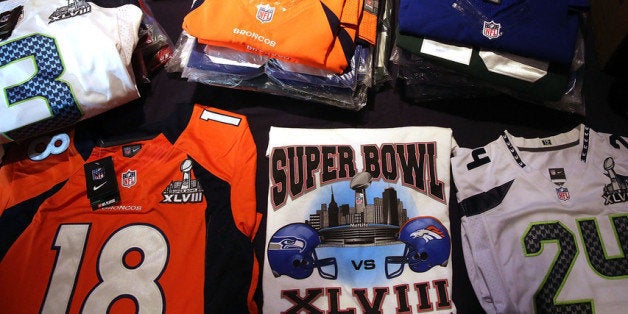
The price of a Russell Wilson game jersey found on one website is about $20. A Broncos infant onesie on the same site sells for around $5.
Too good to be true? Probably.
As Seattle Seahawks and Denver Broncos fans gear up for Sunday's Super Bowl, it's likely that some will sport -- knowingly or unknowingly -- counterfeit jerseys, jackets, T-shirts and hats that they purchased online or in stores. But it's not just quality and the economy that may be compromised, according to experts. The phony products could also expose wearers to toxic chemicals.
"People may be trying to save a buck, impress their friends, show off their team's colors," said Andrew Munoz, a spokesman for the U.S. Immigration and Customs Enforcement office in Seattle. "But a lot of these pieces end up falling apart after one wash. On top of that, there are health concerns."
Federal authorities in New York City, right across the state line from New Jersey where this year's Super Bowl will be played, reported on Thursday that they have seized more than 202,000 imitation NFL items, as well as 163 websites selling knock-offs since Operation Team Player began in June.
Like shipments of tainted children's shoes, jewelry and cosmetics -- the FBI released a warning about the health hazards of counterfeit makeup and fragrances in early January -- some fan products are still believed to have slipped under the radar and across the border.
"Most of these counterfeits are coming from China. We don't know what conditions they are being made in. We don't know what dyes and other chemicals they're using," said Munoz, noting seizures of Chinese goods in the past have tested "high in lead, cadmium and other chemicals used in these types of clothing."
But the confiscated Super Bowl items have not been tested for heavy metals or other toxic chemicals, noted Justin Cole, a U.S. Immigration and Customs Enforcement spokesman in New York. "Children's toys are a big concern. But there's been no reason to worry and go down that route [with apparel]," he said.
Scott Wolfson, a spokesperson with the U.S. Consumer Products Safety Commission, agreed. "We really haven't seen that as an area where we've actually done any enforcement or seen a need for a public announcement," he said.
Still, other experts and advocates are taking the risk seriously. "I don't want to make it overblown," said Munoz, "but the concern is real."
In January, environmental advocacy group Greenpeace reported hazardous chemicals in children's clothes and shoes made by major brands, including Disney, Burberry and Adidas.
Even though contaminants still turn up, name brands do have a market incentive to follow regulations and keep toxic chemicals out of their products. In fact, several companies, including Nike, have pledged to eliminate hazardous chemicals from their supply chains by 2020. Counterfeiters, on the other hand, don't have high standards.
"They'll go for the cheapest and easiest, and that tends to be the most toxic compounds out there," said John Deans, an analyst for Greenpeace's Toxics Campaign.
Still, he cautioned, without testing, there is no way to be sure counterfeit products are more toxic than the major brands. “Part of the problem is that in manufacturing countries like China and Indonesia, there are not many restrictions, so the whole market has the potential to be toxic,” said Deans.
Plasticizers such as phthalates, which studies have found can disrupt human hormones, are often used in the synthetic fabrics and in the plastic-like ink used to put names and numbers on jerseys, Deans noted. Lead and cadmium also may be part of the mix. Mounting evidence links exposures to very low levels of lead with brain damage, reproductive disorders, cardiovascular disease and a host of other health problems. The biggest risks are faced by pregnant women and young children.
Such dangers were also among those underscored in a consumer guide to fake clothing, published by the Italian Ministry for Economic Development in November 2012.
"It is easy to find traces of chemical coloring agents and paints which are harmful to health," reads the report. "Over time, the chemicals are gradually absorbed by the skin."
Still, the bigger health risks, according to Deans, may come through the manufacturing, care and eventual disposal of the tainted products.
"When people wash the jersey after the season's over -- because, of course, you can't wash it until the season is over -- phthalates become available in the environment," he said.
Whether flowing out with laundry wastewater, or released from a landfill or incinerator, heavy metals and plasticizers can end up in the air, soil or water, and result in new exposure to the public.
Cole said that while it's possible some confiscated Super Bowl gear could eventually be donated to charity, most of it would be destroyed. The seizures continue, and new counterfeit merchandise figures to be released next week will surpass the current total of more than $21.6 million, he said.
Ultimate victory over the imitators is unlikely. Feds face an ongoing game of whack-a-mole; while they continually upgrade their fake-finding tools, criminals seem to find new ways to fool them.
"Counterfeiters are getting very good at what they do," said Munoz.
From slick web designs that mimic authentic NFL stores to the use of the official NFL hologram, both feds and consumers can be easily duped.
"Everyone knows how much these luxury goods cost. If it looks too good to be true, people should think twice before buying that jersey or T-shirt for their kids or themselves," Munoz advised.
